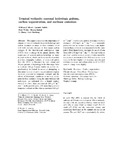Tropical wetlands: seasonal hydrologic pulsing, carbon sequestration and methane emissions
Date
2010Author
Mitsch, W.J.
Nahlik, A.
Wolski, P.
Bernal, B.
Zhang, L.
Ramberg, L.
Publisher
Springer, http://www.springer.comType
Published ArticleMetadata
Show full item recordAbstract
This paper summarizes the importance of climate on tropical wetlands. Regional hydrology and carbon dynamics in many of these wetlands could shift with dramatic changes in these major carbon storages if the inter-tropical convergence zone (ITCZ) were to change in its annual patterns. The importance of seasonal pulsing hydrology on many tropical wetlands, which can be caused by watershed activities, orographic features, or monsoonal pulses from the ITCZ, is illustrated by both annual and 30-year patterns of hydrology in the Okavango Delta in southern Africa. Current studies on carbon biogeochemistry in Central America are attempting to determine the rates of carbon sequestration in tropical wetlands compared to temperate wetlands and the effects of hydrologic conditions on methane generation in these wetlands. Using the same field and lab techniques, we estimated that a humid tropical wetland in Costa Rica accumulated 255 g C m−2 year−1 in the past 42 years, 80% more than a similar temperate wetland in Ohio that accumulated 142 g C m−2 year−1 over the same period. Methane emissions averaged 1,080 mg-C m−2 day−1 in a seasonally pulsed wetland in western Costa Rica, a rate higher than methane emission rates measured over the same period from humid tropic wetlands in eastern Costa Rica (120–278 mg-C m−2 day−1). Tropical wetlands are often tuned to seasonal pulses of water caused by the seasonal movement of the ITCZ and are the most likely to be have higher fire frequency and changed methane emissions and carbon oxidation if the ITCZ were to change even slightly.
Collections
- Research articles (ORI) [270]

